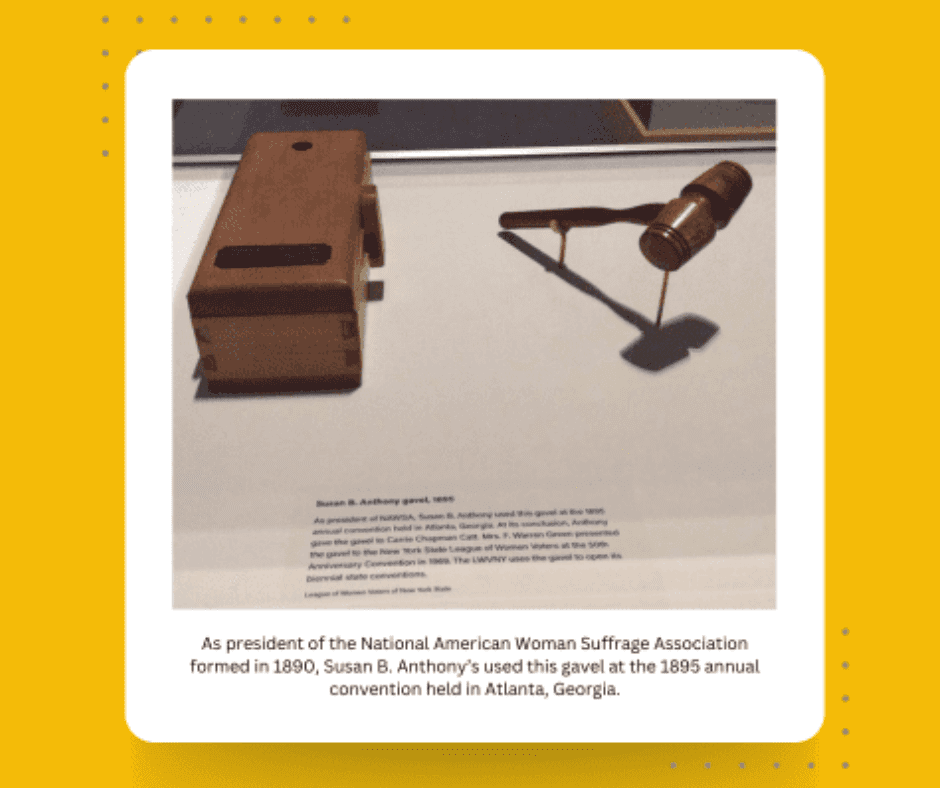“I Am a Quaker”
The Women’s Suffrage Movement & My Education in Quakerism
By Dare Thompson
“…Unlike the American Revolution, which began with the shot heard round the world,’ the rebellion at Seneca Falls – steeped in moral conviction and rooted in the abolitionist movement – dropped like a stone in the middle of a placid lake, causing ripples of change. No governments were overthrown, no lives were lost in bloody battles, no single enemy was identified and vanquished. The disputed territory was the human heart and the contest played itself out in every American institution: our homes, churches, schools, and ultimately in the provinces of power…”
From a foreward by Geraladine Ferraro in The History of the American Suffragist by Doris Weatherford
I have heard often about the importance of the women’s rights convention of 1848 in Seneca Falls, so beautifully articulated above by the first woman to run for vice president of our country. But it was not until I went there in August 2016 as a member of the newly formed New York Women’s Suffrage Commission that I discovered that the people who dropped that “stone” were almost all Quakers!
Our group met in the very warm and slightly stuffy top floor of the M’Clintock House, part of the Women’s Rights National Historical Park in the town of Waterloo, just west of Seneca Falls. The sign out front had told me that the M’Clintocks (Thomas, a pharmacist, and Mary Ann) were Quakers, so I felt especially connected as I climbed the narrow steps to the top floor. There are only about a dozen of us on the official commission but we nevertheless filled the room. New York’s Lt. Governor, Kathy Hochul, would quickly be elected chair of the commission but first we all introduced ourselves.
As president of the League of Women Voters (LWV) of NYS, I’m sure I mentioned that my organization was “the living legacy of the suffrage movement” since the LWV was formed directly out of the American Woman Suffrage Association, led for many years by Susan B. Anthony (famously a Quaker). But I was starting to grasp how little I really knew about suffrage history – such as the fact that the room we were in was where Elizabeth Cady Stanton, Lucretia Mott, Mary Ann M’Clintock and many Quaker friends of theirs actually created the Declaration of Sentiments that was to be the founding document of the American women’s suffrage movement. In awe of the history that had happened in that small, ordinary room, we could almost feel the walls vibrate with our foremothers’ spirits.
After discussing plans to celebrate New York women getting the vote in 1917 and all U.S. women getting the vote in 1920, many of us headed to the museum in Seneca Falls. A tour was going on, led by a woman in full mid-19th century costume who was speaking as Elizabeth Cady Stanton. She was standing next to a crowd of statues (slightly smaller than normal size but still plenty big and quite overwhelming in their number), and she started explaining who several of them were. It became Quaker this and Quaker that as she spoke … BOOM! I realized how ignorant I was about the history of my own religion! I went to First Day School at Cleveland (Ohio) Meeting, graduated from a college (Swarthmore) founded by Lucretia Mott, my sisters went to the even older Quaker boarding school (Westtown). So how did I not know these things? What must other people not know?
As she started to lead us next door to the Wesleyan Chapel where the historic women’s rights convention of 1848 was held, I worked my way up to “Elizabeth,” careful not to step on her dress, and said I had some questions about the Quakers’ role. In a Melinda Grube voice – that is, momentarily and clearly herself, not Elizabeth– she said, sotto voce, “I AM a Quaker” which I took to mean, “find me later!” Though delighted by this discovery, I had to join a tour by a board member of the National Women’s Hall of Fame which was located in a storefront down the block. A few of us Commission members also donned hard hats and toured the 1844 Seneca Knitting Mill building directly across the canal that it hoped to move into by 2020 (and is doing!)
This delayed my return to the museum and I feared Elizabeth/Melinda would be gone, but there she was at the information desk, chatting with a female Ranger. “I hoped you’d come back, “she said, and thus began a conversation not just about the role of Quakers but also about the racism that Elizabeth in particular is accused of and the ways the museum is dealing with it, and so much more.
In this conversation and others that followed, I became increasingly impressed not only with Melinda’s grasp of history but with her ability to “become” Elizabeth, a woman about whom she once told me, “I would have had trouble being in the same room with her!” Elizabeth was never officially a Quaker, although she often told people she was, but Melinda IS a Quaker and her family attended Poplar Ridge Friends Meeting until they moved to Orleans County, northeast of Buffalo.
Feeling strongly that more Quakers should know about the Quaker contribution to women’s suffrage, particularly as we were about to celebrate the centennial of our winning the vote, I persuaded Melinda to come to Cornwall for a Nine Partners Quarterly Meeting, along with Renee-Noelle Felice, who is the re-enactor for Lucretia Mott at Seneca Falls and a now-and-again Quaker. They worshipped with us and then conversed as the spirited Elizabeth (1815-1902) and the more prudent but equally brave Lucretia (1793-1880), telling us how they met in 1840 at the World Anti-Slavery Convention. Though official delegates, they were not allowed on the floor with the men because they were women, and their outrage was still smoldering when they met again in Seneca Falls in 1848. Elizabeth’s fire and radical thinking and Lucretia’s fine reputation even beyond Quaker circles seemed to be just what was needed to launch a movement. Toss in a tight network of Quakers who could get the word out, a remarkable turn-out including the powerful presence of 30-year-old Frederick Douglass, and the world was not to be the same.
Where, you might ask, was Susan B. Anthony in all this? Elizabeth and “Aunt Susan,” as she became known in the Stanton household, the “pen” (Elizabeth) and the “feet” (Susan) of the women’s movement, were not to meet until 1851 in a moment commemorated in a sculpture there in Seneca Falls. (It’s across from Café 19 in Generations Bank. Don’t miss its modern portraits of our foremothers!)
On my trips to Seneca Falls and to women’s history conferences I have also been privileged to get to know Judith (Judy) Wellman, a Quaker from Fulton, NY, and a professor emerita at SUNY Oswego. Judy is a former historian at the Women’s Rights National Historical Park and her book, The Road to Seneca Falls, is a must-read for anyone studying the 1848 Convention. She has also been tireless in her work on the 1816 Farmington Meetinghouse near Rochester and women’s suffrage and the Underground Railroad are her favorite areas of study.
So starting at pathetic, I have moved to the “somewhat informed” level of understanding of Quaker history in New York. That history is rich and complex, and like all history, constantly unfolding since the more I know, the more questions I have. But let me briefly share some local connections to that history.
Beyond discovering personal connections including my beloved maternal grandmother’s great grandparents buried in a Waterloo cemetery, I found important Nine Partners/Oakwood connections. Few people know that Susan B. Anthony’s father, Daniel, went to Nine Partners school and that one of Susan B’s early homes was in the Albany area. More (and so) significantly, Lucretia Coffin and James Mott met when James was a teacher at that school and Lucretia came as a student from Nantucket. She eventually taught there too and was disillusioned to learn that, even accounting for seniority, men got paid more than women. While Lucretia is the star player at the 1848 convention, James Mott officially opened the meeting because (or so I heard) the women were overwhelmed by how many people had showed up. He soon backed away and let the women run the convention as originally intended.
The biggest question that hangs over the history of women’s suffrage for Quakers and also for the LWV is racism, and books will continue to be written on this topic. Elizabeth Cady Stanton is especially being blamed for inexcusably racist statements made when black men won the vote before women. These created a rift between her and long-time friend and abolitionist colleague, Frederick Douglass. But even abolitionists weren’t necessarily free of racist beliefs and it is an area of study that is particularly interesting today as we all examine hidden pockets of belief that are inconsistent with our higher values. This alone makes the story of women suffrage worth a much longer article. But on that, for now, you’ll have to wait.

